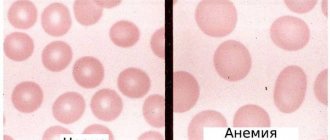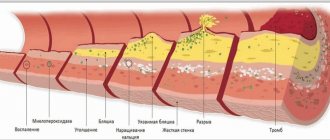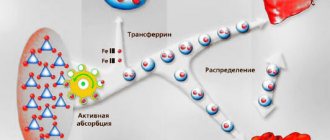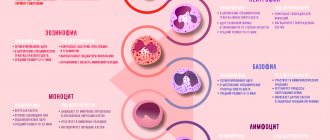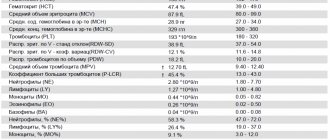Reasons for the increase
This condition occurs only in the presence of certain diseases.
Excess levels of total protein can be absolute or relative. In the first case, this is due to a change in the volume of circulating blood, and in the second - with thickening of the plasma. An increase in total protein levels is called hyperproteinemia
The absolute reasons for exceeding the norm of total protein are:
- Malignant tumors that have their own metabolism and actively synthesize proteins.
- Infectious diseases of acute form or occurring in a severe stage. At the same time, they are accompanied by the spread of purulent lesions and blood poisoning.
- Autoimmune diseases. These include lupus and rheumatoid arthritis. Such pathologies manifest themselves in the form of the body producing antibodies to its own immune cells.
- Parasitic infections. Increased protein in the blood is observed in the presence of roundworms in the intestines.
- Inflammatory diseases of a chronic type, characterized by constant destruction of body tissues.
- Diseases of the cardiovascular system.
Relative causes of increased protein levels contribute to a decrease in the concentration of water in the vessels, resulting in dehydration of the body. A similar condition is observed in the following pathologies:
- Intestinal infections, which are accompanied by frequent and loose stools. Such diseases include cholera, dysentery and others. With these diseases, elevated protein levels in the blood are established.
- Intestinal obstruction. Pathology occurs against the background of difficulty in the absorption of liquid from the digestive tract.
- Poisoning with food or drugs, which is accompanied by frequent vomiting and diarrhea. The result is dehydration.
- Intense bleeding. Against the background of their occurrence, there is a large loss of fluid, which causes an increase in total protein.
- Long-term use of corticosteroid drugs. They provoke an increase in the amount of vitamin A.
It is impossible to determine the cause of high total protein in the body based on the results of a laboratory blood test. For this, the patient is prescribed a number of other studies. Also, when making a diagnosis, the doctor relies on the patient’s existing symptoms and medical history.
Total protein in the blood during pregnancy
During pregnancy, the female body undergoes certain changes. They are expressed not only externally. In the early stages, only internal changes in the level of certain substances in the body, including total protein, are observed.
But during pregnancy, this indicator decreases slightly as blood volume increases. In cases where the indicator is significantly exceeded and is more than the norm, the reason for such deviations should be found out.
The reasons for the increase in protein in the blood of a pregnant woman may be:
- Infectious diseases of an acute nature.
- The presence of malignant formations, when the protein begins to be synthesized in larger quantities than required.
- Autoimmune diseases such as chronic hepatitis, systemic lupus erythematosus, reactive arthritis and others.
- Lack of fluid in the body due to diarrhea, vomiting or intestinal obstruction.
Timely identification of the causes of this condition will eliminate the development of complications and a number of fetal pathologies.
- Total protein in the blood is low - what does this mean, causes and treatment
How to make up for protein deficiency
If protein deficiency was not caused by nutritional factors, then primary attention should be directed to the cause leading to their difficult breakdown and absorption. It is the elimination of this etiological factor that will provide the body with a sufficient amount of proteins - otherwise, everything eaten simply will not be absorbed.
As a rule, the leading role is occupied by hypochlorhydria - a decrease in the secretion of hydrochloric acid by the parietal cells of the stomach. If its cause is a violation of the folate cycle, it is worth starting to work with it, taking a course of active forms of vitamins involved in its mechanisms:
- methylfolate;
- methylcobalamin;
- riboflavin 5-phosphate;
- pyridoxal 5-phosphate.
Provided there is no damage to the gastric mucosa, you can also consider the use of dietary supplements that stimulate the secretion of hydrochloric acid:
- Betaine-pepsin.
- Iodine, chlorine and zinc.
In addition, exposure to stress factors that lead to vasospasm should be reduced or completely eliminated. Increase the tone of the parasympathetic system: as you know, it is the vagus nerve that controls the digestive processes. Take baths with magnesium salts, do relaxing practices like Pilates, yoga, breathing exercises.
Suitable as adaptogens for reducing cortisol levels:
:
- Rhodiola rosea;
- valerian;
- ginseng.
We recommend
“Enzyme deficiency: symptoms and treatment” Read more
Lifestyle changes play a key role in normalizing the condition of the entire body. Move more - let 10,000 steps become not something supernatural for you, but a familiar, everyday norm. Eliminate simple sugars from your diet as much as possible: especially if the cause of impaired secretion of digestive juices lies in the syndrome of excessive fungal or bacterial growth.
Go to bed early: at 11 p.m., the secretion of melatonin, an antioxidant hormone responsible for youth, beauty and actively counteracting the development of oxidative stress, begins. In addition, the release of other, no less important hormones: TSH and somatotropin is also tied to the sleep-wake cycle.
What is C-reactive protein
h22,0,0,0,0—>
In the results of blood biochemistry, among the protein indicators, you can find a separate type of protein - C-reactive protein (abbreviated as CRP or CRP). This substance belongs to the acute phase proteins or dominant proteins, which are produced at an accelerated rate during damage to body tissues and the development of inflammatory reactions. The protein mobilizes the immune system to fight foreign antigens and activates defense mechanisms. Today it is considered to be a marker of inflammation in the body, much more sensitive than ESR. When a pathological process develops in tissues, the concentration of C-reactive protein quickly increases tenfold.
p, blockquote8,0,0,0,0—>
Some tips
- We must remember that you cannot eat the same foods. The diet should be varied.
- Many high protein foods are high in fat, so their consumption should be limited. These are fatty meats, milk, chicken eggs.
- You need to increase the amount of protein food gradually, especially if you are not used to it. Ingesting a large amount of protein at once can be stressful for the body. The digestive system may not accept such food, resulting in poisoning. Therefore, it is best to distribute the total amount of protein foods into five or six meals, but not eat in two or three meals.
Reasons for the increase
h24,0,0,0,0—>
A condition in which the concentration of proteins in the blood increases is called hyperproteinemia. It can be absolute, if the change in the amount of proteins is not associated with disturbances in blood volume, or relative, if the shift in concentration is due to blood thickening and fluid loss.
p, blockquote16,0,0,0,0—>
Factors that provoke protein levels are the same for adults and children. There are no specific reasons for patients of different age categories. Absolute hyperproteinemia in most cases is associated with the destruction of body tissue and metabolic disorders. It can be caused by:
p, blockquote17,0,0,0,0—>
- diseases of a malignant nature (sarcoidosis, lymphogranulomatosis, tumors of internal organs);
- autopathologies (rheumatoid arthritis, systemic lupus erythematosus, scleroderma, autoimmune hepatitis);
- chronic inflammatory processes (protein indicator reflects the dynamics of development);
- severe infections (leptospirosis, syphilis, tuberculosis, malaria, sepsis, purulent-necrotic processes);
- blood diseases (leukemia, iron deficiency anemia).
Relative hyperproteinemia is much more common than absolute hyperproteinemia. It is short-lived and more often associated with transient conditions. The concentration of proteins can increase against the background of a decrease in blood volume, with significant losses of its liquid part, namely:
- Total protein in the blood: norms and causes of deviations
p, blockquote18,0,0,0,0—>
- loss of water due to diarrhea and vomiting due to intestinal infections (salmonellosis, dysentery, cholera, rotavirus);
- impaired fluid absorption due to obstruction and inflammatory diseases;
- acute intoxication;
- burns of more than a fifth of the body area;
- hemorrhages (overt massive or prolonged hidden);
- taking glucocorticoid drugs, some NSAIDs, antibiotics, vitamin A;
- after surgical operations;
- for significant injuries.
In addition, an increase in protein concentration is not due to pathological reasons. These include dietary habits, loss of fluid by the body in hot conditions, when drinking a small amount of water, after physical exertion or severe stress.
p, blockquote19,0,0,0,0—>
When C-reactive protein (CRP) increases
h31,0,0,0,0—>
CRP reacts with lightning speed to any inflammatory and necrotic changes in the body. By the degree of increase in protein, you can determine how serious the violations are. The indicator increases when:
Useful information: Nitrites in urine - causes, treatment. What to do with nitrituria and is the condition dangerousp, blockquote20,1,0,0,0—>
- transition of chronic diseases to the acute phase;
- activation of inflammatory changes;
- development of allergic reactions;
- acute infectious diseases (bacterial or viral);
- burns, frostbite;
- injuries;
- the formation of foci of purulent tissue melting.
C-reactive protein can indicate the formation of a cancerous tumor in the body. The indicator changes at the earliest stages, when other blood characteristics are still within normal limits and there are no symptoms.
p, blockquote21,0,0,0,0—>
Causes of low blood protein
Heart disease may cause hypoalbuminemia
- Impaired albumin formation in liver diseases: cirrhosis, tumors, hepatitis, hepatosis.
- Decreased protein synthesis due to chronic and acute heart failure.
- Impaired protein absorption due to endocrine disorders, inflammatory processes in the intestines, exocrine pancreatic insufficiency.
- Accelerated breakdown of albumin as a result of infectious infections, extensive injuries and burns, rheumatic pathologies, sepsis.
- Increased protein loss in nephrotic syndrome, characterized by damage to the glomerular apparatus of the kidneys.
- Impaired glomerular filtration of the kidneys as a result of damage to the renal blood vessels in diabetes mellitus.
- Insufficient protein intake during strict diets and fasting.
- In newborns, the cause of HA may be immaturity of liver cells.
- Pregnancy.
What does total protein concentration mean?
h21,0,0,0,0—>
- C-reactive protein is an important indicator in the diagnosis of rheumatoid arthritis
Proteins, or proteins, are constantly present in the blood and are transported throughout the body. Thanks to them:
p, blockquote3,0,0,0,0—>
- coagulation reactions are triggered;
- metabolism occurs and is regulated;
- nutrients and nutrients are transported;
- a stable volume of the bloodstream is maintained;
- immune mechanisms are triggered;
- blood elements are in a suspended state and do not stick together.
The constancy of the protein indicator is the key to homeostasis in the body - stable blood properties and the continuity of metabolic processes in tissues, the connection between all organs and systems. Protein levels can be measured in plasma or serum. The first is the liquid fraction of blood, purified from formed elements. Serum is plasma purified from fibrinogen protein. Because of it, the value of total blood protein increases by 2–4 g/l.
p, blockquote4,0,0,0,0—>
Whey proteins are conventionally divided into 2 types. The first group - albumin - makes up about 55%. These proteins are produced primarily in the liver. They provide transport of pigments, hormones, vitamins, and pharmacologically active substances. Albumins prevent the liquid part of the blood from sweating through the vascular walls into the tissue. If their concentration changes, edema may develop.
p, blockquote5,0,0,0,0—>
The second group is globulins. These substances include enzymes, antibodies, and other substances (about 500 types in total). Thanks to them, nutrients are distributed throughout the body.
p, blockquote6,0,0,0,0—>
p, blockquote7,0,0,0,0—>
Why are proteins needed?
Proteins perform many functions in the human body. First of all, it is a building material - those bricks on which the foundation of all organs and tissues is laid. They create the framework of cells - their cytoskeleton, participate in the formation of organelles of movement - and by the way, thanks to the latter, leukocytes are able to leave the systemic bloodstream in the direction of the source of inflammation. It is the connective tissue collagen that largely gives structure not only to the skin, but, say, to blood vessels. In turn, keratin is part of nails and hair.
Protein molecules carry out signal transmission, mediating intercellular interactions, transport hormones, fatty acids, and form complexes with a variety of biologically active substances. Those of them that do not circulate in the serum, but are built into the plasma membrane - a selective barrier at the border of the intra- and extracellular environments - are an important factor in the regulation of water-salt balance: by forming ion channels, they facilitate the entry of potassium, sodium and some others into the cytoplasm charged particles.
One of the most important functions performed by this class of organic compounds is undoubtedly catalytic. All enzymes are protein in nature - and this mediates strict conditions (including a certain temperature and pH), deviations from which in the slightest direction lead to a kind of transport collapse at the molecular and cellular levels. So, say, many remember from school biology lessons: an excessive increase in temperature is fraught with denaturation of protein molecules - in essence, their destruction. Here, as a rule, the analogy with fried eggs is clear: just think what “metamorphoses” happen to a chicken egg as soon as it hits a hot frying pan.
In addition, a large number of hormones are also represented by polypeptides and proteins - this allows us to highlight the regulatory effect as a separate item: both local and at the level of the entire organism (take, for example, thyroid hormones, the influence of which begins with cellular metabolism and ends with entire organ systems ).
Preparing for protein testing
On the eve of the test, you should limit physical activity
Preparation for analysis involves eliminating those factors that may adversely affect its accuracy:
- Drinking enough fluids - blood must be donated on an empty stomach, but it is not recommended to exclude the use of water;
- Elimination of overeating - the day before the analysis, you should refrain from eating large amounts of meat and fish;
- Reducing sports load - it is not recommended to engage in sports 1-2 days before the test.
Protein deficiency is a painful condition of the body associated with insufficient intake and absorption of protein or with its increased breakdown. A true deficiency in protein intake from food can develop in people who have been undernourished for a long time, adhering to so-called mono-diets, or in vegetarians. Secondary protein deficiency, associated with its increased breakdown, can accompany a number of diseases, for example, severe forms of infectious diseases, burns, kidney pathologies, and hereditary metabolic disorders. Proteins are the main building material of the body, so even mild forms of protein deficiency, which are outwardly asymptomatic, affect the ability to resist infection or the rate of wound healing, slow down the growth of nails and hair, and cause dry skin. Severe protein deficiency can disrupt the normal functioning of all organs and systems. Protein deficiency in childhood is especially dangerous, as it can affect the development of mental abilities, muscle formation, and slow down the child’s growth.
Timely detection of protein deficiency and establishment of its cause is extremely important, as it allows one to avoid life-threatening complications.
Synonyms Russian
Protein deficiency, protein dystrophy, protein-energy deficiency.
English synonyms
Protein Deficiency.
Symptoms
Mild forms of protein deficiency are most often asymptomatic. An exception may be hereditarily determined deficiencies of individual amino acids (structural components of the protein molecule), the characteristic signs of which are observed in early childhood.
External manifestations of protein deficiency:
- general weakness;
- progressive weight loss;
- fragility, dullness and hair loss;
- brittle nails;
- dryness and flaking of the skin;
- swelling.
Manifestations from the nervous system:
- lethargy and increased fatigue;
- headache;
- decreased mental activity;
- unstable mood;
- insomnia.
Manifestations from the musculoskeletal system:
- pain in muscles and less often in joints;
- slow growth (in children);
- reduction in muscle mass and apparent volume;
- muscle weakness.
From the digestive organs:
- increased craving for sweets;
- nausea;
- abdominal pain and bloating;
- stool disorders (constipation followed by diarrhea);
- liver enlargement.
Who is at risk?
- Population of countries with low living standards.
- Vegetarians.
- Persons following a mono-diet or fasting in order to lose weight.
- Patients with kidney diseases.
- Patients with diseases of the digestive system.
- Persons with a hereditary predisposition to protein metabolism disorders.
- Persons with professionally caused weight deficiency: ballerinas, models, gymnasts.
- Persons over 60 years of age.
General information about the disease
Proteins are among the essential nutrients that perform the following functions in the body.
- Construction - protein is part of all cells of the human body and, in fact, is the basis for the existence of life.
- Frame – proteins are involved in the formation of hair and nails, form the protective membrane of the eye, cartilage, tendons and ligaments. Even such a property as the smoothness of the skin directly depends on the protein it contains.
- Motor and contractile. Proteins are the main component of muscle tissue that ensures its functioning.
- Transport. Many proteins have the ability to bind to nutrients contained in the blood and transport them to organs and tissues. An example of a transport protein is hemoglobin, contained in red blood cells (erythrocytes) and transporting oxygen.
- Protective. The body produces specific proteins (antibodies) that provide protection against microorganisms and viruses.
- Enzymatic. Enzymes are proteins that are involved in all chemical processes occurring in the body (for example, in the digestion of food).
- Hormonal. Most of the hormones in the human body are proteins.
The implementation of these functions occurs due to protein metabolism - constantly occurring processes of protein formation (synthesis) and breakdown.
The main causes of protein deficiency:
- Severe and long-term illnesses require the body to use all its reserves. Proteins are spent to replenish energy costs and restore dead cells. In a number of diseases, significant protein loss occurs.
- Chronic kidney disease (glomerulonephritis, renal failure, nephrotic syndrome) can lead to the excretion of significant amounts of protein in the urine (proteinuria), causing a drop in protein levels and chronic protein deficiency.
- Liver cirrhosis and liver failure can cause protein deficiency, especially in the later stages of the disease, when edema develops - fluid containing large amounts of protein (ascites) can accumulate in the abdominal cavity. The liver synthesizes many proteins necessary for the body, and the digestive enzymes it produces are involved in their absorption. With cirrhosis, normal liver function is disrupted and protein deficiency may develop.
- Burns (burn disease). With thermal burns, blisters filled with protein-containing liquid may form on the skin. Protein losses when opening these bubbles can be quite significant.
- Diarrhea (diarrhea) is characterized by a significant loss of fluid and digestive juices containing proteins.
- Malignant neoplasms in late stages can lead to severe protein deficiency. The protein is spent on tumor growth, and is also lost during its decay and bleeding. Substances formed in tumor cells are foreign to the body. Once in the blood, they cause poisoning by decay products (cancer intoxication syndrome), one of the manifestations of which is a drop in protein levels.
- Diabetes mellitus can cause protein deficiency due to increased protein breakdown, as well as diabetic kidney damage and secondary proteinuria.
- Disorders of protein-amino acid metabolism. Proteins are complex substances that, like a chain, are made up of units called amino acids. The sequence of amino acids is individual for each organism, therefore the protein supplied with food during the digestion process is broken down to the level of individual links, from which its own sequence is then composed. At the same time, some amino acids can be formed in the human body, while others (they are also called essential) come only from food. The role of essential amino acids is so great that without them, protein formation becomes impossible. If any essential amino acids are missing from the diet or are not absorbed, the balance between protein breakdown and synthesis may shift toward breakdown and lead to protein malnutrition.
- Impaired digestibility of essential amino acids is a hereditary pathology. The following diseases are most significant in the development of chronic protein deficiency.
- Phenylketonuria is a metabolic disorder of the amino acid phenylanine. Phenylanine is involved in the formation of almost all proteins of the human body, primarily proteins of the nervous system. The disease is characterized by the absence or insufficient level in the liver of a special protein (enzyme) responsible for the absorption of this amino acid. As a result, its excessive accumulation in tissues occurs. Phenylketonuria is usually diagnosed in early childhood and is accompanied by various disorders of the nervous system, as well as retardation in physical development. Without treatment, it can lead to mental disability.
- Tyrosine metabolism. Tyrosine is an amino acid necessary for the formation of one of the main protein pigments of the human body - melanin, therefore one of the manifestations of impaired metabolism is albinism (pale skin, discoloration of hair and iris). Tyrosine is also required for the formation of thyroid hormones.
- Disturbances in protein synthesis can lead to insufficient protein formation or the appearance of so-called defective, or pathological, proteins that are unable to perform their functions. For example, with a hereditary disease such as sickle cell anemia, hemoglobin is detected in the blood, which is not able to carry the same amount of oxygen as normal. Acquired disorders of protein synthesis can be caused by malignant tumors or taking certain medications.
- Alimentary (digestive) protein deficiency is the most common form of protein deficiency. It can develop under the following circumstances:
- Insufficient protein intake from food. Some diets include limiting animal protein (meat), replacing it with vegetable protein, or completely eliminating proteins. Prolonged fasting can also lead to protein deficiency. In the latter case, irreversible protein breakdown may begin, which poses a threat to life.
- Protein digestion disorders can develop in diseases of the gastrointestinal tract, accompanied by insufficient production of digestive juices, for example, in atrophic gastritis with reduced secretory function.
Depending on the severity, protein deficiency can lead to:
- retardation in mental and physical development;
- weakening of memory and intelligence;
- weakening of the body's defense system.
Diagnostics
Protein deficiency may be primarily suspected in patients with underweight, as well as in individuals with symptoms of diseases characterized by protein deficiency. To confirm the diagnosis, a complex of studies is carried out.
Laboratory research
- A general blood test is one of the basic tests.
- The level of red blood cells and hemoglobin may be reduced (anemia) in patients with severe forms of protein deficiency and general exhaustion. A normal content of red blood cells with a low level of hemoglobin can be observed when it is insufficiently formed or excessively destroyed. This condition is called hypochromic anemia.
- Leukocytes. An increase in the number of leukocytes with the appearance of young cells in the leukocyte formula may indicate an infectious-inflammatory process that is the cause of protein deficiency.
- Erythrocyte sedimentation rate (ESR) is also an indicator that indicates an inflammatory process as the cause of protein deficiency.
- A general urine test is essential in excluding or confirming a renal cause of protein deficiency. Includes studying the following parameters.
- Urine color. Normally it is assessed as straw yellow. Red or brown discoloration may occur when blood enters the urine (hematuria) and indicates serious kidney problems. Dark brown urine, especially in combination with jaundice, is characteristic of liver disease.
- Transparency. Normal urine is clear. In case of kidney diseases, it becomes cloudy due to a significant content of pus (pyuria) or salts.
- The specific gravity of urine is an indicator of the efficiency of the kidneys. With protein deficiency caused by kidney damage, it can decrease significantly.
- Protein is normally absent in a urine test. If the test is positive (proteinuria), a quantitative determination of protein in the urine is carried out and its composition is necessarily examined. Albumin is the most commonly detected type of protein, but other proteins may also be detected, such as immunoglobulins, hemoglobin, myoglobin, and others. The degree of proteinuria allows us to indirectly judge the level and severity of kidney damage.
- Urine testing using special test strips is carried out to detect proteinuria - the release of protein in the urine. A positive result may be the first indication of a renal origin of protein deficiency. In this case, microscopy of the sediment is necessary. Urine sediment examination:
- Red blood cells - erythrocytes of protein deficiency caused by kidney pathology, can be present in the urine in large quantities. The presence of altered discolored red blood cells allows one to suspect glomerular damage (glomerulonephritis).
- Cylinders are formed in the renal tubules from protein, leukocytes, erythrocytes, and epithelium. Identification of casts, especially protein casts, may indicate a renal origin of protein deficiency.
- Protein in blood serum. The study is the “gold standard” for studying protein metabolism and confirming protein deficiency. Protein levels in blood plasma and tissues are in a state of equilibrium. With the loss of tissue protein, the level of plasma proteins also decreases, which determines the significance of this parameter.
- Protein fractions of blood serum. Determination of the quantitative composition and ratio of protein types in blood serum. Total serum protein is represented by albumins and globulins, which perform various functions. The main part is albumin, the main building protein of the body. Fluctuations in its level to the greatest extent reflect the state of protein metabolism. Globulins are more specific in their purpose. These are proteins of the defense system, markers of inflammatory reactions and special transport proteins. Under various pathological conditions, the ratio and amount of proteins of one type or another can change significantly, and in some cases additional (pathological) protein fractions appear. Based on the ratio of individual fractions of the protein composition of the blood, one can to some extent judge the cause of protein deficiency. For example, if the liver and kidneys are damaged, albumin levels may decrease. Globulins increase during inflammatory processes, reflecting the activity of inflammation or the immune (protective) system. A decrease in globulin levels may indicate diseases of the renal tubules, and can also be observed with impaired liver function and when the body’s immune system is suppressed (as in severe forms of sepsis).
- Glucose (blood sugar). Determination of glucose levels may be prescribed if protein deficiency due to diabetes is suspected. Kidney damage in diabetes mellitus (diabetic nephropathy), as well as increased protein breakdown, can cause protein deficiency.
- Urea and creatinine in blood serum. These are substances formed during the breakdown of proteins. With intensive protein destruction, their level in the blood may increase. The indicator should be assessed together with the level of urea in daily urine.
- Urea in daily urine reflects the efficiency of the kidneys. With intensive protein breakdown, it can increase significantly. A low level of urea in the urine with an increase in it in the blood is more typical of renal failure.
- Creatinine in daily urine is an indicator of impaired excretory capacity of the kidneys, which is indicated by a decrease in its level. For a more accurate assessment, creatinine clearance is calculated, which is the ratio of its levels in daily urine and blood. In renal forms of protein deficiency, this indicator can decrease significantly.
- Coprogram is a stool examination that allows you to identify possible violations of the main stages of digestion. The chemical composition of feces, their color, smell, consistency are assessed, and certain types of microorganisms (dysbacteriosis) are identified. The analysis allows you to evaluate the activity of the main enzymes of the liver, gastric and intestinal juice, and pancreas. With protein deficiency caused by impaired protein absorption, undigested muscle fibers may be found in the stool.
Additional (instrumental) research methods
The scope of diagnostic tests depends on the suspected cause of protein deficiency and should be determined by the attending physician. The main diagnostic methods include:
- Ultrasound examination of the abdominal organs. A doctor may prescribe it to rule out diseases of the liver and pancreas, as well as kidneys. it combines high information content and safety for the patient. Ultrasound passes through soft tissue to the organ being examined and, after being reflected, returns back. The resulting image is transmitted to the monitor. The study allows you to assess the size of internal organs, the structure of their tissues, identify a tumor lesion or cyst, and exclude the presence of fluid in the abdominal cavity. If necessary, the study can be supplemented with an ultrasound-guided biopsy.
- Esophagogastroduodenoscopy. It is a direct examination of the esophagus, stomach and duodenum. The patency of the upper digestive tract, the condition of the mucous membrane, the degree of its inflammation or atrophy are assessed. During the examination, a piece of tissue may be taken for analysis (biopsy). Along with ultrasound, gastroscopy is mandatory if a nutritional protein deficiency is suspected.
- Daily pH measurements. This is the study of daily fluctuations in the acidity of gastric juice. A probe with a sensor at its end is placed in the stomach, and the information coming from it is recorded by a portable device attached to the patient's belt. The main part of the protein supplied with food is digested in the stomach under the influence of hydrochloric acid and pepsin, an enzyme that breaks down protein. If the acidity of gastric juice is reduced, protein digestion may be impaired.
- Enteroscopy (intestinoscopy). Examination of the small intestine. The study is similar in its capabilities to gastroscopy, but is technically more complex, since it involves examining the entire small intestine. Allows you to assess the condition of the mucous membrane, exclude erosive lesions and take the contents for analysis to exclude an infectious process.
- Colonoscopy is an examination of the large intestine. For protein deficiency, it can be prescribed to patients with suspected intestinal tumors or ulcerative colitis, in which significant protein loss is likely.
Treatment
Treatment of protein deficiency is aimed at replenishing protein volume and normalizing protein metabolism. At the same time, the underlying disease is treated.
It may include the following items.
- Recommendations for a balanced or protein-enriched diet (with sufficient animal protein). Including meat, eggs, fish, caviar in the diet. For patients with protein deficiency caused by kidney disease, liver disease, or diabetes mellitus, the diet should be selected by the attending physician, taking into account the characteristics of the course of the underlying disease. Such a correction of the diet may be the only necessary measure in case of a mild form of protein deficiency.
- Medications:
- solutions containing a complex of amino acids or protein components of blood intended for intravenous administration; treatment with these drugs is carried out under the strict supervision of a doctor in a hospital setting;
- special nutritional mixtures can be prescribed to patients with severe forms of protein deficiency due to diseases of the gastrointestinal tract or in the postoperative period; these are special protein cocktails that are introduced into the stomach or duodenum through a tube when normal nutrition is impossible;
- Digestive enzymes are used for replacement purposes by patients who do not produce enough of them.
Prevention
- A balanced diet with sufficient amounts of plant and animal proteins.
- Mandatory medical supervision during a diet that strictly limits the diet, or during courses of therapeutic fasting.
- Timely detection and treatment of diseases that increase the risk of developing white deficiency.
Recommended tests
- General blood analysis
- Leukocyte formula
- Erythrocyte sedimentation rate (ESR)
- General urine analysis with microscopy
- Rehberg test (endogenous creatinine clearance)
- Urea in daily urine
- Creatinine in daily urine
- Total protein in urine
- Total protein in whey
- Protein fractions in whey
- Serum creatinine
- Urea in serum
- Plasma glucose
- Coprogram
Immunological blood test
Few people know what blood tests there are from the point of view of the human immunological system, since these tests are not so common. As a rule, such a blood test provides information about the immunodeficiency virus in the human body and is anonymous, since it is carried out at the request of the patient. For sampling, blood taken from a vein on an empty stomach is used, from which serum is obtained for testing by centrifugation. In addition, the study of blood serum can detect a number of sexually transmitted diseases (syphilis, herpes, chlamydia), as well as all types of hepatitis, measles, rubella, mumps and toxoplasmosis.
Basically, for ELISA analysis, the biological material being studied is blood, however, cerebrospinal fluid, vitreous contents, amniotic fluid, etc. can be examined.
What is immunoglobulin (antibody)?
Immunoglobulins are immune molecules that can bind to and neutralize most infectious pathogens and toxins in the body. In this case, the most important characteristic of immunoglobulins is their specificity, that is, the ability to bind to a specific antigen. It is this property that is used to conduct a blood test for immunoglobulin.
There are five types of immunoglobulins, but the most studied are immunoglobulins A, M, and G. Immunoglobulins M and G show their activity in the blood. Immunoglobulins A are a kind of barrier on the surface of the mucous membranes, as they are present there in large quantities.
An immunological blood test allows you to determine the type of immunoglobulins, thanks to which ELISA allows you not only to diagnose the disease, but also to determine the stage of the disease and monitor the dynamics of the disease:
- In the first 2 weeks of the disease, only immunoglobulins A are detected.
- From the 2nd to the 3rd week of the disease, immunoglobulins A and M are detected in the blood.
- From 3 to 4 weeks, a blood test for immunoglobulin determines all three types.
- During recovery, immunoglobulins M disappear from the blood, and the amount of A and G decreases by 2–4 times.
- In the presence of a chronic process, immunoglobulins G are necessarily present in the blood, immunoglobulins M are absent, immunoglobulins A may or may not be present.
Advantages of enzyme immunoassay (ELISA):
- Relatively high sensitivity (accuracy).
- Reasonable price.
- Allows for early diagnosis (due to the ability to determine immunoglobulin classes during analysis).
- Allows you to monitor the dynamics of the infectious process (thanks to the ability to determine immunoglobulin classes).
- Ease of use.
- An immunological blood test allows you to get a quick answer.
Disadvantages of ELISA blood test:
- Sometimes enzyme immunoassays give false positive or false negative results.
Scope of application of immunological blood test
- Diagnosis of viral diseases: hepatitis, herpes, Epstein-Barr virus, cytomegalovirus, etc.
- Sexually transmitted infections: chlamydia, gonorrhea, trichomonas, mycoplasma, ureaplasma.
- Syphilis.
- Endocrinology (determination of hormone levels).
- Tumor markers (diagnosis of cancer).
- Immunology (diagnosis of immunodeficiency).
- Allergology (diagnosis and treatment of allergies).
Serological blood test is a laboratory method of blood testing that is used to diagnose infectious diseases and determine the stage of the infectious process. The serological reaction is based on the interaction of antibodies and antigens.
Determination of antigens is used to determine the genus and species of microorganisms. This research method is used in urology and venereology. Blood for a serological blood test is taken in the morning on an empty stomach from a vein.


